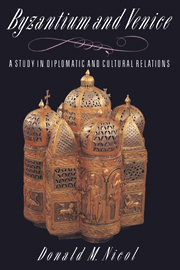Book contents
- Frontmatter
- Contents
- Dedication
- Preface
- List of abbreviations
- Maps of the Byzantine and Venetian worlds
- 1 Venice: the Byzantine province
- 2 Venice: the Byzantine protectorate
- 3 Venice: the ally of Byzantium
- 4 Venice: the partner of Byzantium
- 5 Byzantium, Venice and the First Crusade
- 6 The parting of the ways
- 7 The calm before the storm
- 8 The Fourth Crusade
- 9 Venice in Byzantium: the Empire of Romania
- 10 Venice: champion of a lost cause
- 11 Byzantium, Venice and the Angevin threat
- 12 Byzantium, Venice and Genoa
- 13 Conflicting interests and competing claims
- 14 Byzantium, Venice and the Turks
- 15 Byzantium: the victim of commercial rivalry
- 16 The profit and honour of Venice
- 17 Jewels for an island
- 18 Byzantium in thrall to the Turks and in debt to Venice
- 19 Byzantine optimism and Venetian vacillation
- 20 Byzantium the suppliant of Venice
- 21 The worst news for all of Christendom: Venice and the fall of Constantinople
- 22 Legacies and debts
- Byzantine Emperors
- Doges of Venice
- Bibliography
- Index
- Frontmatter
- Contents
- Dedication
- Preface
- List of abbreviations
- Maps of the Byzantine and Venetian worlds
- 1 Venice: the Byzantine province
- 2 Venice: the Byzantine protectorate
- 3 Venice: the ally of Byzantium
- 4 Venice: the partner of Byzantium
- 5 Byzantium, Venice and the First Crusade
- 6 The parting of the ways
- 7 The calm before the storm
- 8 The Fourth Crusade
- 9 Venice in Byzantium: the Empire of Romania
- 10 Venice: champion of a lost cause
- 11 Byzantium, Venice and the Angevin threat
- 12 Byzantium, Venice and Genoa
- 13 Conflicting interests and competing claims
- 14 Byzantium, Venice and the Turks
- 15 Byzantium: the victim of commercial rivalry
- 16 The profit and honour of Venice
- 17 Jewels for an island
- 18 Byzantium in thrall to the Turks and in debt to Venice
- 19 Byzantine optimism and Venetian vacillation
- 20 Byzantium the suppliant of Venice
- 21 The worst news for all of Christendom: Venice and the fall of Constantinople
- 22 Legacies and debts
- Byzantine Emperors
- Doges of Venice
- Bibliography
- Index
Summary
Constantinople and Venice, the two richest and most romantic Christian cities in the early Middle Ages, were separated by the many nautical miles of the Aegean and Adriatic seas. To sail from one to the other might take six to eight weeks. Yet they were bound together by long tradition, by mutual needs of defence, by commerce and by culture. Venice was born as a province of the Byzantine or East Roman Empire, linked by the ties of a remote provincial city to its capital in Constantinople, the New Rome. It grew into an ally, came of age as a partner and matured as the owner of extensive colonial possessions within the disintegrating structure of the Byzantine world.
In theory Byzantium and Venice were friends, however distant. Their relationship went back to the fifth century. In practice they were often at variance. They differed in language, in the form of their Christian faith, and above all in politics. Byzantium, the heir to the ancient Roman tradition, never forsook the idea of universal imperium. Venice was less demanding, more subtle and more realistic. Venice was a republic, hedged about by aspiring western kingdoms and empires which were nearer and more threatening than Byzantium. The Venetians lived by the sea and the trade that went by sea. The Byzantines preferred the dry land. They had an imperial navy but no great merchant fleet. Their ruling class regarded trade as rather beneath their dignity. Since Constantinople was the centre of the world, at the point where Europe and Asia meet, they expected the trade of the world to come to them. They never mastered the intricacies of capitalism and a market economy.
- Type
- Chapter
- Information
- Byzantium and VeniceA Study in Diplomatic and Cultural Relations, pp. vii - viiiPublisher: Cambridge University PressPrint publication year: 1989



